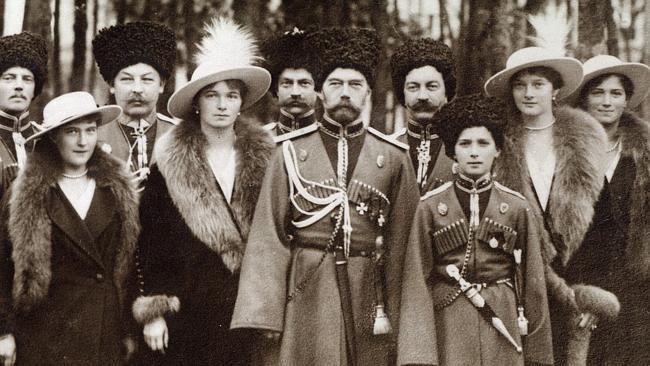Beyond Catherine the Great, Romanov dynasty is a rich romp
Simon Sebag Montefiore’s feisty history of the Romanovs ventures from battlefields to bedrooms.

Barbra Streisand reportedly has signed on to direct a biopic about Catherine the Great. Yet another? Sure, Catherine was powerful, intelligent and amorous, but the entire Romanov dynasty is a marvellously rich bag of deshabille, despotism and occasional diplomacy, as Simon Sebag Montefiore’s feisty history brilliantly displays. His research scours archives and lurks in bedrooms to demonstrate incontrovertibly that ‘‘Russia is always exceptional’’.
Direct succession was relatively rare in a dynasty in which only members of the (extended) Romanov family could mount the throne. Nineteen monarchs were bookended by two Michaels, the first, in 1613, pious and sweet-natured; the last the almost forgotten tsar-for-a-day uncle of Nicholas, in 1918. In between, as the Russian empire grew by 150sq km a day, the medieval legacy of opulence, religion and brutality endured into the 20th century.
While Michael I’s days were dominated by church services, bloodthirsty generals punished his enemies, often with death by rectal impalement. Potential wives were forced to parade in ‘‘brideshows’’. A monk prescribing household management advised that virtuous wives should be regularly whipped but not punched — bruises showed. Michael’s son Alexei ordered that a Cossack rebel be knouted, disjointed, burned with a red-hot iron, dismembered, quartered alive, beheaded and his innards fed to dogs. Yet Alexei rode into battle wearing a pearl-encrusted robe and seated in a gilded carriage lined with crimson satin, drawn by horses with pearl-studded hoofs.
Peter I, the Great, despite his huge height and roaring personality, made an ‘‘incognito’’ trip to Holland and England, to learn shipbuilding and to observe a parliament. Occupying John Evelyn’s house, the Russian contingent used ‘‘paintings for target practice, furniture for firewood, and curtains as lavatory paper’’. But Peter defeated the armies of Poland and Sweden, making Russia a great power; Romanov girls could now be married off to European princes. Nevertheless, during the construction of St Petersburg, Peter put his wife in a convent and took up with a Lithuanian laundress whom he married, first in secret, and then with pomp and dwarfs (indispensable court accessories).
Sixteen years and three brief monarchies after Peter’s death, his second daughter, Elizabeth, the ‘‘Russian Venus’’, ascended the throne. She rearranged the European chessboard but at home only slightly modified established practices, arresting and beheading rebellious males, stripping and beating females before having their tongues ripped out. Yet she adored balls, famously promoting cross-dressing so that she could display her excellent legs.
Montefiore credits Elizabeth with restoring imperial authority, though the cost of everything from the national army to the imperial wardrobe (4000 dresses lost in a Moscow fire) fell on ... who else but the peasants? Forbidden to take the oath of allegiance, they amounted to chattels, bought, sold, exiled to Siberia.
Childless, Elizabeth settled her succession by arranging a marriage between two distant, teenage Prussian second cousins. The unhappy liaison uniting Peter II to Sophie of Anhalt-Zerbst, later Catherine II, ushered in what Montefiore justly calls a golden age, thanks largely to Catherine’s tact, intelligence and wealth. It is regularly asserted that she ordered the coup that destroyed her doltish husband; in reality she let her favourite, Orlov, act for her. Heavily pregnant to him, she was roused early one summer morning and told to ride into the city, where the palace guard would come out in her favour. She set off still in her nightcap. A French hairdresser was summoned. Monsieur Michel ‘‘arranged Catherine’s hair on the way to the revolution’’.
That wonderful line typifies Montefiore’s best; but Catherine produced one too, when her announcement that Peter died of ‘‘haemorrhoidal colic’’ became a euphemism for strangulation. Montefiore captures an important clue to Catherine’s success when he quotes her definition of ‘‘the foundation of unlimited power’’ as doing ‘‘things in such a way that people think it’s what they want done’’. She was wise even about her own weaknesses: ‘‘My heart can’t be without love even for an hour.’’ The court learned that the future statesman Potemkin had replaced Orlov when a stream of light and sounds of love-making emanated from the bathhouse. At the age of 61, when Catherine was stout and swollen-legged, she took a lover aged 22. ‘‘By educating young men I do a lot of good for the state,’’ she explained.
Countless illuminating details, gleaned through arduous dedication to scarcely used archives, stud the pages of The Romanovs. During the early, mutually charmed relationship between Alexander I and Napoleon, the latter told Josephine, ‘‘Were he a woman I think I would make him my lover.’’ When enmity replaced infatuation, Napoleon insisted to Alexander, ‘‘The private feelings I bear towards you are not in the least affected by these events.’’ After the monumentally stirring, intensely bloody Battle of Borodino — ‘‘the most gorgeously dressed abattoir in history’’ — ‘‘both dazed commanders believed uneasily that they had just won’’.
The ensuing Congress of Vienna was ‘‘perhaps the most self-indulgent international junket of all history ... [T]wo emperors, five kings, 209 reigning princes, about 20,000 officials … and just about every gold-digger, mountebank, and prostitute in Europe, maybe 100,000 in all, bargained, blackmailed and fornicated their way through banquets and balls to reshape a continent.” The best bon mot came from a lady whose husband was dancing: Alexander suggested occupying his place. ‘‘Does Your Majesty take me for a province?’’ she asked.
Wading through these records, Montefiore remarks, ‘‘Rarely have police files been so entertaining.’’ Indeed. Archives containing the letters of Alexander II to his mistress Katya were smuggled into Paris, where they lay neglected until the Rothschilds exchanged them for banking records held by the Soviets, and restored them to Moscow. Alexander and Katya’s correspondence regarding their enthusiastic and inexhaustible delight in sexual congress still awaits cataloguing.
Despite the reforms of Alexander II, most notably the emancipation of the serfs in 1861, the movement to rid the country of autocracy muttered threateningly but amateurishly throughout the 19th century. It took an intrepid young woman, Sophia Perovskaya, to mastermind the bomb plot that killed Alexander in 1881. Amid the horrific references to ‘‘bloody chunks of human flesh’’ as the tsar lay in the snow, blood pouring from his shattered legs, it sounds odd to read that a colonel of the palace guard ‘‘asked if he was OK’’. Montefiore uses neologisms (“The love-in was as hot as ever’’) and words (uxoricidal, paradomaniacal) that can jar, but the gems (‘‘even in the 18th century some babies were the children of their official parents’’) are priceless.
The idiosyncratic mishmash in the transcription of Cyrillic to which Montefiore pleads cheerfully guilty is arguably less justifiable. Elizaveta rather than Elizabeth, but Catherine not Ekaterina is confusing, and why Fyodor but not Potyomkin? But few will quibble as they guzzle down this immensely enjoyable work (aptly arranged in dramatic Acts and Scenes rather than artificially neat chapters) where love affairs are endemic and public life, whether in peace or war, full-blooded and totally enthralling.
Judith Armstrong’s most recent book is War & Peace and Sonya.
The Romanovs 1613-1918
By Simon Sebag Montefiore
Hachette Australia, 608pp, $45 (HB)


